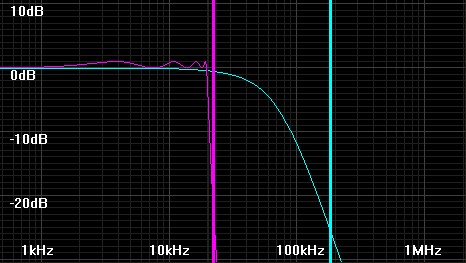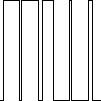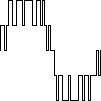Copyright © 2012 by Wayne Stegall
Updated April 20, 2012. See Document History at end for
details.
Digital Audio Formats
Introduction
Sony discontinued its last SACD player recently. I thought it
well to revisit the different digital audio formats: why they are
different and why high resolution formats are better than the
44.1kHz/16bit format of CD.
Density Modulation
Analog digital systems require signal formats that originate and look
digital but which yield their underlying analog signal simply by
lowpass filtering. These signals are linear because a linear
filter can recover the original signal from the composite signal
containing an error signal creating the sharp digital edges.
Where
f(t) is the analog
signal and
e(t) the modulated
quantization noise
f(t)
+ e(t)
|
 |
Analog
LPF
|
 |
f(t)
|
|
- PAM - Pulse Amplitide Modulation
PAM is simply the time sampled analog
signal produced by sampling the
analog signal on the sampling clock transition and holding that value
until the next clock transistion loads the next sample. This
format has the significant advantage of already closely resembling the
analog signal before filtering.
- PWM - Pulse Width Modulation
In PWM the width of each pulse is
proportional to the analog signal
level.
- DSD - Direct Stream Digital (AKA One-bit digital or Bitstream)
A clever circuit known as a delta-sigma
modulator produces a stream of
synchronized pulses the average of which represents the input signal
with unexpectly high resolution. This bitstream format has a
downside. Because signal energy cannot be fully represented by
any single 0 or 1 pulse, the remainder of unspent sound energy is
always passed to the next sample to complete processing. This
smears the signal across pulses in a manner that is effectively random
high-level jitter. Estimating that the energy smeared to the next
pulse is half of that spent or less, peak modulation jitter would be
expected to approximately half a DSD sampling period. Fortunately
DSD operates at much higher clock speeds than does PCM. Single
rate DSD operating at 64x oversampling at 2.8224MHz would calculate
177.154ns jitter on this presumption. On first thought, this
large amount of jitter would be expected to have a bad effect on the
sound, but instead is mitigated greatly by some virtue, likely its
randomness. Consider that smaller amounts of jitter of different
character adversely affect the sound of DACs having a DSD stream in any
form. It is likely then that delta-sigma induced jitter effect is
benign, its only effect to subjectively soften the impact of
high-frequency transients, an effect that some consider euphonic.
Multilevel delta-sigma DACs output a
composite density modulation signal comprised of high-level PAM
modulation added to low-level DSD modulation.
Definitions
Definition of terms or abbreviations used.
- Decimation Filter - A digital filter that downsamples and
applies
lowpass-filtering a one-bit stream to produce its PCM equivalent.
- Delta-Sigma (ΔΣ) Modulator - A circuit that produces a stream of
synchronized pulses the average of which represents the input signal
with unexpectly high resolution. The analog version converts an
analog signal to DSD and digital version converts PCM to DSD.
- Pulse Code Modulation (PCM) - the representation of a sampled
analog signal by a sequence of numbers.
- R2R Ladder DAC - A DAC that transforms PCM to a PAM waveform by
means
of a resistor network having only two values of resistance R and 2R
implemented by combined R valued resistors. The PCM signal
switches
the input taps and the output represents the analog value of the code.
- Sample and Hold (S/H) - A circuit that creates a PAM waveform
from an
analog signal by switching the analog signal through a switch to a
small capacitor at regular clock intervals.
- Successive approximation ADC (SA ADC) - An analog-to-digial
converter
that systematically guesses the correct PCM code for each sample of an
analog signal presented sample by sample by a sample-and-hold front
end. The guess is feed back through and R2R DAC to be compared to
the
sampled analog signal. The optimized method of guessing requires
only
one guess per bit before returning the best representative PCM code.
The Original Format
The following is the original analog digital signal chain when compact
discs
were first introduced.
Ideal PAM PCM Digital Audio Chain
|
|
PCM ADC
|
|
|
|
PCM DAC
|
|
|
signal
|
 |
Analog
LPF
|
analog

|
S/H
|
PAM

|
SA
ADC
|
|
PCM

|

|
PCM

|
R2R
DAC
|
PAM

|
Analog
LPF
|
|
 |
restored signal
|
The sound of the chain was considered at the time to be inferior to
analog due to
the poor audio quality of the high order elliptical anti-imaging filter
deemed necessary at the end of the chain. Now audiophiles have
found excellent reproduction from this chain if the elliptical lowpass
filter is omitted.
Oversampling
Oversampling the digital audio chain was devised to ease the analog
filter requirements.
Ideal Oversampled PAM PCM Digital
Audio Chain
|
|
PCM ADC
|
|
|
|
PCM DAC
|
|
|
signal
|
 |
| Analog
LPF |
analog

|
S/H
|
PAM

|
SA
ADC
|
PCM

|
Downsampling
Digital Filter
|
|
PCM

|

|
PCM

|
Upsampling
Digital Filter
|
PCM

|
R2R
DAC
|
PAM

|
Analog
LPF
|
|
 |
restored signal
|
By sampling the audio signal some multiple higher than the stored
sample rate then restoring the higher sample rate before conversion
back to analog, the interval between the highest audio frequency and
the highest frequency supported by the oversampled sample rate gives
room for adequate lowpass filtering with more gentle and more musical
analog filters.
On second thought I realized that the successive-approximation ADC
would have become technologically unfeasable to use with oversampling
at this point in development because it operates a number of bits times
faster clock rate than its equivalent DAC. In an 8x oversampled
44.1kHz/16bit system its feedback loop would operate at
5.6448MHz. This difficultly was met then with the development of
the analog ΔΣ modulator. The previous chart the represents an
ideal that met a technological roadblock and also my fantasy of what an
ideal full PAM high resolution chain would consist of. Here is
the more practical oversampled signal chain.
|
|
ΔΣ ADC
|
|
|
|
PCM DAC
|
|
|
signal
|
 |
| Analog
LPF
|
analog

|
Analog
ΔΣ Modulator |
DSD

|
Decimation
Filter
|
|
PCM

|

|
PCM

|
Upsampling
Digital Filter
|
PCM

|
R2R
DAC
|
PAM

|
Analog
LPF
|
|
 |
restored signal
|
Graph
illustrating
how
oversampling
improves
analog
filter
application at 44.1kHz sampling
rate.
|

|
Legend:
Magenta: Harsh
eighth-order filter barely meets 22.05kHz
anti-aliasing limit without oversampling. (Here a
Chebychev plot is substituted for a similar appearing elliptical one.)
Cyan: Musical
third-order Bessel filter performs better against
176.4kHz anti-aliasing limit with 8x oversampling. |
A New Idea
Because the R2R resistor ladders in early DACs were expensive to trim
for low
distortion, the invention of the one-bit delta-sigma modulator promised
to
reduced the overall cost of converters by creating a conversion process
whose accuracy relied only on the accuracy of its time base and not on
component tolerances.
One-bit Delta-Sigma PCM chain
|
|
ΔΣ ADC
|
|
|
|
ΔΣ DAC |
|
|
signal
|
 |
| Analog
LPF
|
analog

|
Analog
ΔΣ Modulator |
DSD

|
Decimation
Filter
|
|
PCM

|

|
PCM

|
Upsampling
Digital Filter
|
PCM

|
Digital
ΔΣ Modulator |
DSD

|
Analog
LPF |
|
 |
restored signal
|
A Mixture of New and Old
Because one-bit digital was thought to lack some of the virtues of PAM,
DACs were developed which produced a composite output consisting of PAM
for high level changes plus DSD to fill in the low level detail.
These were named Multilevel Delta-Sigma DACs. The ADC end
remained one-bit however.
Multi-level Delta-Sigma PCM chain
|
|
ΔΣ ADC
|
|
|
|
ΔΣ DAC |
|
|
signal
|
 |
| Analog
LPF
|
analog

|
Analog
ΔΣ Modulator |
DSD

|
Decimation
Filter
|
|
PCM

|

|
PCM

|
Upsampling
Digital Filter
|
PCM

|
Multilevel
Digital
ΔΣ Modulator |
PAM + DSD

|
Analog
LPF |
|
 |
restored signal
|
Eureka!
Digital audio conversions by some date became dominated by delta-sigma
converters. However, conversions between PCM and DSD are
lossy. If PCM is removed from the One-bit Delta-Sigma PCM chain
and the
signal is transmitted as DSD a very simple signal path emerges.
The DSD stream only needs an analog LPF to retrieve the signal from the
digital hash. Because the 64x DSD stream used for CD resolution
converters has always had a equivalent 20-bit resolution, the simple
DSD chain gains high resolution status as well. This is the idea
behind SACD.
Ideal DSD chain
signal
|
 |
Analog
LPF |
analog

|
Analog
ΔΣ Modulator |
DSD

|

|
DSD

|
Analog
LPF
|
 |
restored signal
|
Practical Problems
Debates over which of SACD or DVD-A is better favors DVD-A in the
context of PAM converters. The dominance of delta-sigma
converters lends favor to the simple DSD chain. However when
editing is necessary the PCM and DSD both have nearly the same signal
chain. Only the storage of the signal occurs at a different point
and a different format. This is because DSD signal must be
converted to PCM for editing.
Edited Delta-Sigma PCM chain (DVD-A)
|
|
ΔΣ ADC
|
|
|
|
|
|
ΔΣ DAC |
|
|
signal
|
 |
| Analog
LPF
|
analog

|
Analog
ΔΣ Modulator |
DSD

|
Decimation
Filter
|
|
PCM

|
Digital
Editing |
PCM

|

|
PCM

|
Upsampling
Digital Filter
|
PCM
 |
Multilevel
Digital
ΔΣ Modulator |
PAM + DSD
 |
Analog
LPF
|
|
 |
restored signal
|
Edited DSD chain (SACD)
|
|
ΔΣ ADC
|
|
|
|
Partial ΔΣ DAC |
|
|
|
|
|
|
signal
|
 |
| Analog
LPF
|
analog

|
Analog
ΔΣ Modulator |
DSD

|
Decimation
Filter
|
|
PCM

|
Digital
Editing |
PCM

|
Upsampling
Digital Filter
|
PCM
 |
Digital
ΔΣ Modulator |
|
DSD
 |
 |
DSD
 |
Analog
LPF
|
 |
restored signal
|
Conclusions
All agree that both high-resolution PCM and DSD signal chains improve
over the 44.1kHz/16bit CD format.
1 From there opinions
diverge. PCM has an obvious advantage of more closely resembling
the analog signal before low pass filtering, an advantage attributed to
greater transient sharpness. DSD has a certain softness created
by the noise shaping process that makes it a euphonic preference for
some. As already stated, adding editing to the process makes the
two signal chains similar. Then the following are the only other
considerations. The high resolution PCM signal chain could finish
its chain with added transient sharpness if PAM or the common
Multilevel
Digital ΔΣ DAC's are used. Alternatively the PCM to DSD
conversion near the end of the DSD signal path can be and is likely
processed with optimal algorithms offline from the real-time
limitations that limit the same part of the ΔΣ PCM chain. In the
end, choosing a format is a matter of preference.
1See article
Mathematical
Consideration of Some of the Limitations of Digital Audio for a
discussion of CD format limitations.
Document History
April 18, 2012 Created.
April 18, 2012 Made minor corrections and added a little extra
text.
April 19, 2012 Added graph illustrating how oversampling improves
analog filter application.
April 20, 2012 Added extra material correcting presumptions
contrary to the limitations of the successive-approximation ADC.































































